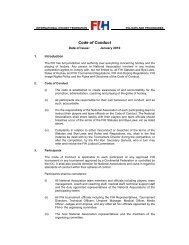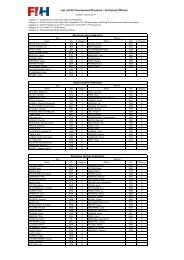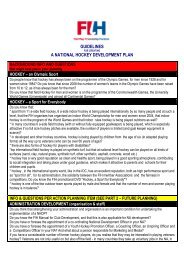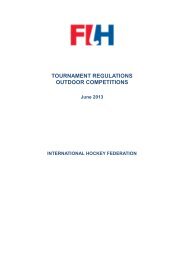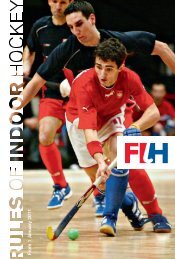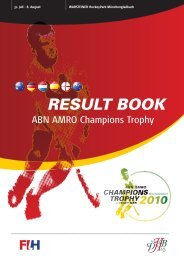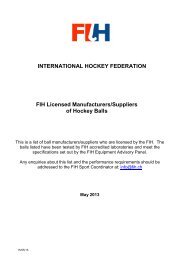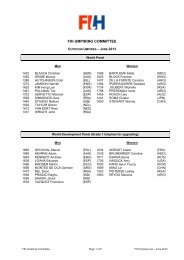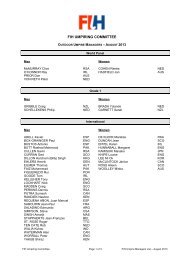Umpire's Handbook - International Hockey Federation
Umpire's Handbook - International Hockey Federation
Umpire's Handbook - International Hockey Federation
You also want an ePaper? Increase the reach of your titles
YUMPU automatically turns print PDFs into web optimized ePapers that Google loves.
INTERNATIONAL UMPIRES HANDBOOK 2005 Appendix 3.Fitness ProgrammeThe Physical Demands of <strong>Hockey</strong> UmpiringUmpires cover up an average of 4000 m in 70 minutes during an international hockeymatch. This comprises of functional running, which is stop-start and is characterised bychanges in speed from jogging to sprinting. It is multi-directional, forwards, backwardsand sideways, and is interspersed with stationary positions including the lunge and thesquat.The intensity at which this work is performed is determined by the nature of the specificmatch. On average 50% of all running is performed at moderate intensity, 10% atmaximal sprinting intensity. There are indications that the demands for high intensityrunning are increasing up towards 16% of total match time.Umpires are not stationary for any significant period of time during a match. This impliesthat recovery from the moderate and high intensity phases work, occur during lowintensity functional running.Fitness training components for hockey umpiresA fitness-training programme for hockey umpiring must aim to develop:1. The muscular strength of the lower limb.2. The speed and agility that is specific to the nature of running that occurs whileumpiring.3. The endurance to be able to perform 4000 m of functional running in 70 minutes,of which approximately 50% or more is at moderate to high intensity.These components of fitness must be developed in phased manner; muscular strength isintroduced and developed prior to speed and agility development, which is followed byendurance training. These components of fitness can be maintained with an emphasis onendurance, during a period of sustained umpiring duty for 2 weeks or more.TRAINING GUIDELINESMuscular strength developmentConsider the following factors when planning the strength training element of your fitnesstraining programme.1. Exercise selection - Exercises that develop the muscles of the lower limb includingthe thighs, hip and legs are most important. Exercises for the upper body areoptional as they enhance general fitness.2. Training frequency - Perform muscular strength training 2- 3 times a weekdepending on the training phase.3. Training volume - perform 3-4 sets of between 8-15 repetitions (reps) for eachexercise, which is also dependent on whether the training objective is developmentor maintenance.



